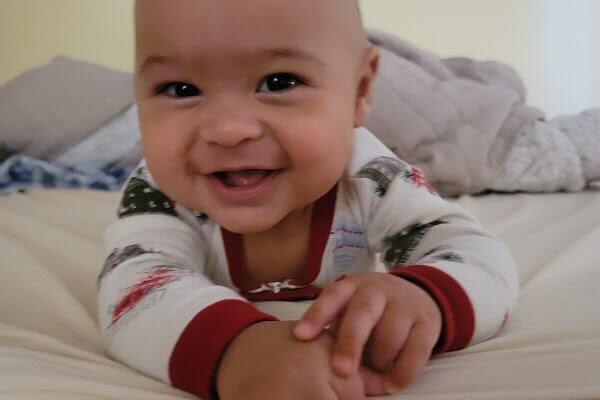By Pauline Nardella
RN, MPA, CCE, CIMI
Touch is the first form of non-verbal communication that a baby receives. A parent’s touch is essential for the normal growth and development of their child. One way parents can lovingly touch their babies is through massage. Research shows that nurturing touch, as in infant massage, has a positive effect on the emotional and physical bonds between infant and parent.
The benefits of infant massage to a baby and caregiver are many. Not only does it strengthen attachment and bonding but it also creates a loving, trusting, joyous relationship with your child that will last a lifetime. Infant massage helps to mature and regulate the circulatory, respiratory and gastrointestinal systems and promotes physical growth. Tender loving touch promotes relaxation, improves sleep and helps to relieve colic.
This is a very brief outline of an infant massage. It is recommended to take a class with a certified infant massage instructor. These classes are filled with so much wonderful information and parental support.
How to begin:
Massage should be done in a warm, quiet, dim lit and relaxed environment. Some parents choose to massage after the daily bath, others will massage at a specific time that is good for them and their infant. Begin by removing your jewelry. Take a few deep meditative breaths and release any tension to allow you to massage your baby with a relaxed energy and a loving heart.
Oil your palms and rub them together to warm them up. It is preferable to use an organic natural oil (apricot, grapeseed) rather than baby oil or lotion. Place your hands onto the baby’s chest for a brief moment (“resting hands”) and convey deep relaxation to your baby. Request permission from your baby for the massage. Most babies will let their caregiver know if they are ready for a massage or if the timing is not right.
For more, go to the next page…
{pagebreak}
Begin with the legs and feet. Rest your hands on the leg of choice. Say “Relax,” as you cup the leg in your resting hands. Once the baby relaxes the leg say, “Good relax.” You will do this resting hand maneuver on each body part before you massage the area.
Now, begin with a basic stroke with gentle squeezing pressure on the leg in your hand as you bring your hand down from the hip to toes. Once to the foot, alternate hands and begin the same stroke. The stroke should be firm enough to massage the muscle. This stroke can be repeated a few times. Move to the foot and walk your thumbs over the sole of the foot. Next massage each little toe while saying, “This little Piggy.” Repeat the sequence with the other leg and foot.
Oil your hands as needed and move to the abdomen with resting hands. Massage in half moon circles beginning in the baby’s right lower quadrant and moving to the left lower quadrant. Massage from the center of the chest outward, as if you are flattening the pages of a book. Resting hands on the arm and begin stroking down the arms in the same fashion as you did the legs and again roll each finger as you recite a childhood rhyme.
{pagebreak}
Do not add more oil to your hands as you stroke the face beginning with the forehead and again using thumbs work from the center outward as if flattening the pages of a book. You can do “Peek-a-boo” with this stroke. Make small circles around those chubby cheeks and roll the outer edges of the earlobes. Move your hands down the side of the neck and under the chin.
Turn your baby over, oil your hands and do resting hands on the back. Now gently rub from side to side with both hands from the shoulders down to the bottom. Use your whole hand and stroke from the back of the head to the tips of the toes. This stroke can get lighter and lighter as it signals the end of the massage. Now give your baby a kiss to grow on.
Note: When taking an infant massage class, the instructor will include information on gross and fine motor movements, brain building activities and massage for colic and other gastrointestinal upsets.
Resources:
–Infant Massage: A Handbook for Loving Parents, by Vimala McClure
–Loving Hands: The Traditional Art of Infant Massage, by Frederick Leboyer, M.D.
–Massage for Healthier Children, by Marybetts Sinclair
–Nurturing Touch, by Kalena Babeshoff and Juliana D. Bavolek
–Touching: The Human Significance of the Skin, by Ashley Montagu
About the author:
Pauline Nardella, RN, MPA, CCE, CIMI is a mother of three and resides in Blauvelt, NY. As a maternal child health nurse, she has been teaching childbirth and parenting classes for over 17 years and is an adjunct clinical nursing professor for Dominican College. Contact: www.BirthingWisdom.com
Learn how to increase the bond with your baby with this step-by-step guide.



